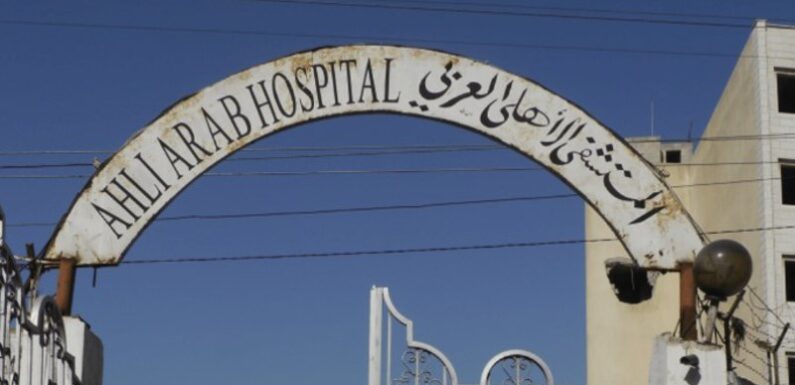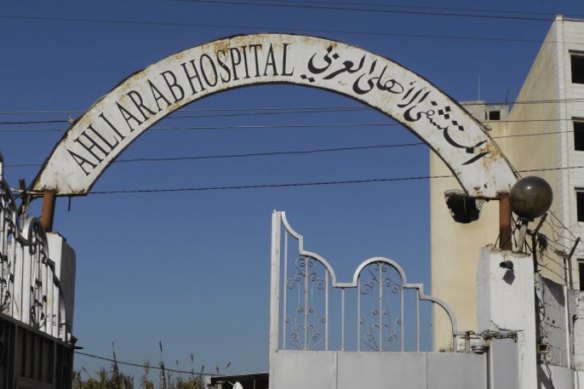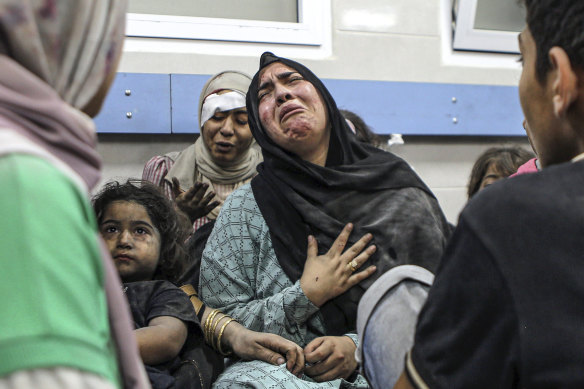
Save articles for later
Add articles to your saved list and come back to them any time.
London: A blast at a Gaza hospital killed hundreds of Palestinians just before US President Joe Biden visited Israel as the conflict between the Israeli military and the Hamas militant group raged.
Al Ahli Arab Hospital in Gaza.Credit: Anglican Alliance
Who bombed the hospital in Gaza?
Israelis and Palestinians have blamed each other for the hospital bombing.
Biden, who has stood squarely behind Israel from the start of the conflict, said that based on information he had seen the hospital blast appeared to be the result of an errant rocket fired by a “terrorist group”, echoing Israel’s view.
Some Western countries have called for an investigation, without pointing the finger at this stage, while Arab states have blamed Israel.
Wounded Palestinians Ahli Arab hospital at the al-Shifa hospital, following the explosion in Gaza City.Credit: AP
What do we know about the hospital?
Founded 1882 and run by the Anglican church, Al Ahli Arab Hospital described itself on its website as “a haven of peace in the middle of one of the world’s most troubled places”. The hospital said it offered 80 beds with services such as a free programme to detect breast cancer, a centre for elderly women, and a mobile clinic offering free services to surrounding towns.
It is located in the Zeitoun neighbourhood of Gaza City, in the northern region of the Gaza Strip.
How many people were in the hospital?
Although it had a limited number of beds, the hospital and others in Gaza have been crammed with casualties beyond their capacity since the start of Israeli air strikes launched in response to the October 7 Hamas attack on Israel.
As well as handling a surge in the number of wounded, people have also sought refuge in hospital grounds all over Gaza believing them to be safe havens against strikes.
Dr Fadel Naim, head of orthopaedic surgery, said about 1000 people were in Al Ahli Arab Hospital on Tuesday morning and more rushed there later in the day after he said the Israeli army had warned residents in the Zeitoun neighbourhood to evacuate their homes.
Dr Ibrahim Al-Naqa said more than 3000 people had sought refuge at the hospital at the time of the strike.
What happened before the strike?
Israel previously told Palestinians in the north of Gaza, including in Gaza City, to move south for their own safety. Israel’s military specifically told Zeitoun residents to move south on Tuesday in a message issued on social media platform X.
The Kuwaiti specialised hospital in Rafah city, in the south of Gaza, said on October 16 it had it had received two Israeli warnings to evacuate but its director said its staff would not leave.
What details do we have about the strike?
Dr Naim said he had finished one surgery and was about to start another when he heard a huge explosion. Dr Naqa said the blast took place at about 6.30pm. (2.30am Wednesday).
What damage was sustained?
Footage and images obtained by Reuters from inside the hospital showed about two dozen destroyed vehicles in its grounds.
They were surrounded by damaged buildings with windows blown out. Blood stains were on the walls and the ground.
What have the Palestinians said?
Palestinian officials have blamed Israel.
Islamic Jihad, a Palestinian militant group that is an ally of Hamas, denied any of its rockets were involved in the blast, saying it did not have any activity in or around Gaza City at that time.
Hamas leader Ismail Haniyeh said the United States was responsible, saying Washington had given Israel “the cover for its aggression”.
The health minister of the West Bank-based Palestinian Authority blamed Israel for what he called a “massacre”.
What has Israel said?
Israel has denied it was to blame and said the blast was caused by a failed rocket launch by Islamic Jihad.
An Israeli army spokesperson said an analysis of the operational systems of the Israel Defence Forces indicated that a barrage of rockets was fired by militants in Gaza, passing in close proximity to the hospital at the time it was hit.
“Intelligence from multiple sources we have in our hands indicates that Islamic Jihad is responsible for the failed rocket launch which hit the hospital in Gaza.”
A military spokesperson said there was no structural damage to buildings around the hospital and no craters consistent with an air strike. The spokesperson said Hamas had inflated the casualty numbers and said the group could not know as quickly as it claimed what caused the blast.
The military said some 450 rockets fired from Gaza had fallen short and landed in the Gaza Strip in the past 11 days.
What has the United States said?
Biden pointed the finger of blame at Palestinian militants.
Speaking alongside Israeli Prime Minister Benjamin Netanyahu, Biden said: “I was deeply saddened and outraged by the explosion of the hospital in Gaza yesterday, and based on what I’ve seen, it appears as though it was done by the other team, not you.”
What has the Anglican Church said?
Justin Welby, the Archbishop of Canterbury and head of the Anglican church, said: “This is an appalling and devastating loss of innocent lives. The Ahli hospital is run by the Anglican church. I mourn with our brothers and sisters.”
“I renew my appeal for civilians to be protected in this devastating war. May the Lord God have mercy.”
What has been the reaction in the region?
The strike has inflamed Arab governments and groups in the region. Protesters took to the streets in several Arab countries denouncing what they said was an Israeli strike on the hospital.
Jordan’s King Abdullah blamed Israel for the blast and his country cancelled a summit it was to host in Amman on Wednesday to discuss Gaza with the US president and the Egyptian and Palestinian leaders. Egypt also blamed Israel.
In Lebanon, Iran-based Hezbollah, which fought a war with Israel in 2006, denounced what it called Israel’s deadly attack and called for protests on Wednesday. The Beirut government declared a national day of mourning.
Reuters
More coverage of the Hamas-Israel conflict
- Cascading violence: Tremors from the Hamas attacks and Israel’s response have reached far beyond the border. But what would all-out war in the Middle East look like?
- The human cost: Hamas’ massacre in Israel has traumatised – and hardened – survivors. And in Gaza, neighourhoods have become ghost cities.
- “Hamas metro”: Inside the labyrinthine network of underground tunnels, which the Palestinian militant group has commanded beneath war-ravaged Gaza for 16 years. The covert corridors have long provided essential channels for the movement of weapons and armed combatants.
- What is Hezbollah?: As fears of the conflict expanding beyond Israel and Hamas steadily rise, all eyes are on the militant group and political party that controls southern Lebanon and has been designated internationally as a terrorist group. How did it form and what does Iran have to do with it?
Get a note directly from our foreign correspondents on what’s making headlines around the world. Sign up for the weekly What in the World newsletter here.
Most Viewed in World
From our partners
Source: Read Full Article

